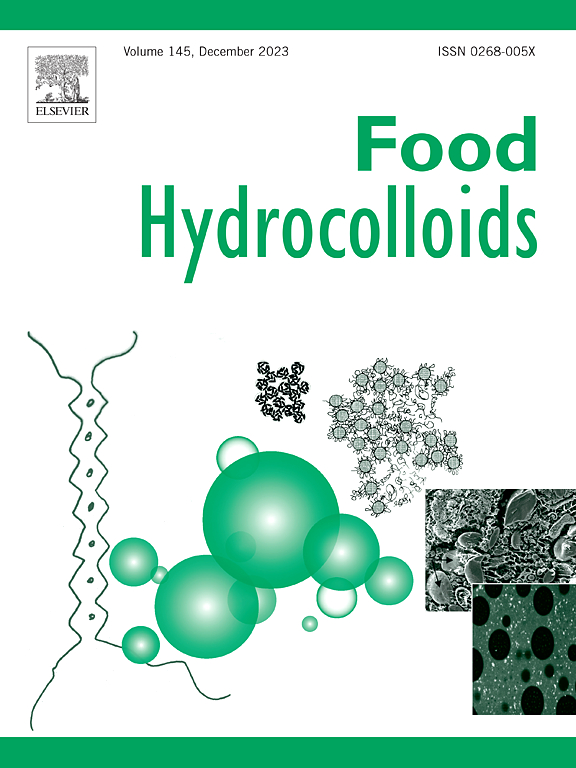小豆分离蛋白作为蛋清蛋白替代品的泡沫特性研究:泡沫衰变机制中的物理化学和界面行为
IF 11
1区 农林科学
Q1 CHEMISTRY, APPLIED
引用次数: 0
摘要
由于对沙门氏菌污染、禽流感和日益增强的环保意识等问题的担忧,对蛋清蛋白(EWP)替代品的需求不断增长,植物蛋白作为一种有希望的解决方案受到了关注。与其他豆类相比,小豆含有丰富的含硫和疏水芳香氨基酸,这可能有助于改善泡沫性能。然而,它们的功能潜力在很大程度上仍未得到开发。本研究考察了小豆分离蛋白(API)相对于EWPs和大豆分离蛋白(SPI)在不同温度和时间条件下的发泡性能。API的泡沫厚度和排水性与EWPs相当,在4°C、25°C和83°C范围内优于SPI。共聚焦激光扫描显微镜(CLSM)和扫描电镜显示,API形成的泡沫结构更细,更球形,破裂较少,而SPI则形成更大,不稳定的气泡。Zeta电位和双荧光CLSM分析表明,API中界面重排较大,其表面疏水性较低,游离巯基(-SH)含量较高,从而增强了流变学中的界面刚度。傅里叶红外光谱分析进一步表明,API与EWPs一样,在受热作用下β-薄片的形成增加,有助于热泡沫的稳定性,而SPI则相反。在一个蛋白酥饼应用中,API显示出比SPI更轻的面糊和更大的空气掺入,突出了它的实用潜力。总的来说,这项研究为控制泡沫形成和腐烂的结构和界面机制提供了新的见解,支持API作为有前途的植物性充气食品系统替代品的潜力。本文章由计算机程序翻译,如有差异,请以英文原文为准。

Insights into the foaming properties of adzuki bean protein isolate as an alternative to egg white protein: Physicochemical and interfacial behaviors in foam decay mechanisms
As the demand for egg white protein (EWP) alternatives grows due to concerns such as Salmonella contamination, avian influenza, and the increasing environmental awareness, plant-based proteins have gained attention as a promising solution. Compared to other legumes, adzuki beans are rich in sulfur-containing and hydrophobic aromatic amino acids, which may contribute to improved foaming properties. However, their functional potential remains largely unexplored. This study examined the foaming performance of adzuki bean protein isolate (API) relative to EWPs and soy protein isolate (SPI) under varying thermal and temporal conditions. API exhibited foam thickness and drainage comparable with those of EWPs and superior to SPI across 4°C, 25°C, and 83°C. Confocal laser scanning microscopy (CLSM) and scanning electron microscopy revealed that API formed finer, more spherical foam structures with fewer ruptures, while SPI showed larger, unstable bubbles. Zeta potential and dual-fluorescent CLSM analysis indicated greater interfacial rearrangement in API, supported by its lower surface hydrophobicity and higher free sulfhydryl (–SH) content, which enhanced interfacial stiffness in rheology. Fourier-transform infrared spectroscopy analysis further revealed that API, like EWPs, showed increased β-sheet formation under heat, contributing to thermal foam stability, whereas SPI exhibited the opposite trend. In a meringue cookie application, API showed a lighter batter with greater air incorporation than SPI, highlighting its practical potential. Overall, this study offers new insight into the structural and interfacial mechanisms governing foam formation and decay, supporting API’s potential as a promising plant-based alternative for aerated food systems.
求助全文
通过发布文献求助,成功后即可免费获取论文全文。
去求助
来源期刊

Food Hydrocolloids
工程技术-食品科技
CiteScore
19.90
自引率
14.00%
发文量
871
审稿时长
37 days
期刊介绍:
Food Hydrocolloids publishes original and innovative research focused on the characterization, functional properties, and applications of hydrocolloid materials used in food products. These hydrocolloids, defined as polysaccharides and proteins of commercial importance, are added to control aspects such as texture, stability, rheology, and sensory properties. The research's primary emphasis should be on the hydrocolloids themselves, with thorough descriptions of their source, nature, and physicochemical characteristics. Manuscripts are expected to clearly outline specific aims and objectives, include a fundamental discussion of research findings at the molecular level, and address the significance of the results. Studies on hydrocolloids in complex formulations should concentrate on their overall properties and mechanisms of action, while simple formulation development studies may not be considered for publication.
The main areas of interest are:
-Chemical and physicochemical characterisation
Thermal properties including glass transitions and conformational changes-
Rheological properties including viscosity, viscoelastic properties and gelation behaviour-
The influence on organoleptic properties-
Interfacial properties including stabilisation of dispersions, emulsions and foams-
Film forming properties with application to edible films and active packaging-
Encapsulation and controlled release of active compounds-
The influence on health including their role as dietary fibre-
Manipulation of hydrocolloid structure and functionality through chemical, biochemical and physical processes-
New hydrocolloids and hydrocolloid sources of commercial potential.
The Journal also publishes Review articles that provide an overview of the latest developments in topics of specific interest to researchers in this field of activity.
 求助内容:
求助内容: 应助结果提醒方式:
应助结果提醒方式:


